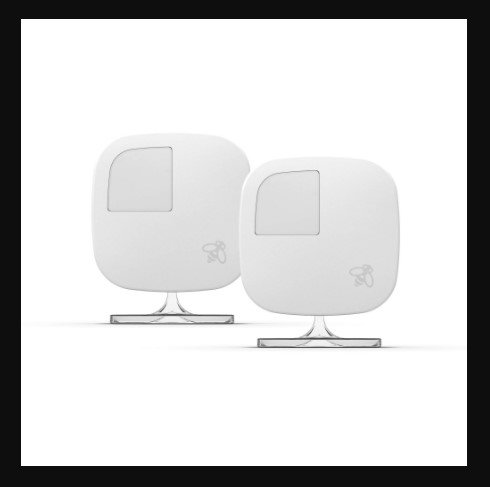Ecobee smart sensor vs. Room sensor; Comprehensive Guide
In smart climate control, Ecobee’s Smart Sensor and Room Sensor offer distinct features that cater to diverse needs, helping us to live a better life. These sensors differ in design, communication range, and battery life, influencing their suitability for various home setups.
In this guide, we’ll unravel the disparities between these two sensors, shedding light on how these distinctions can impact your home’s comfort and energy efficiency. Whether you prioritize aesthetics, extended range, or prolonged battery life, understanding these differences will empower you to make the right choice for your smart thermostat setup.
Table of Contents
Why do we use Ecobee Sensors?
Ecobee sensors play a vital role in optimizing home comfort and energy efficiency when integrated with an Ecobee smart thermostat. These sensors primarily serve three key functions.
Occupancy Detection: Ecobee sensors detect room occupancy, allowing the thermostat to prioritize heating or cooling in occupied spaces. This ensures that energy is not wasted on empty rooms, contributing to significant energy savings.
Temperature Monitoring: The sensors accurately measure room temperatures, enabling the thermostat to fine-tune climate control. This data helps maintain consistent and comfortable temperatures throughout your home, preventing hot or cold spots.
Energy Efficiency: By combining occupancy information with temperature data, Ecobee sensors help minimize energy consumption. They facilitate the thermostat in adjusting settings intelligently, reducing energy waste and lowering utility bills.
Ecobee sensors enhance both comfort and sustainability, making them valuable components of a smart, eco-friendly home heating and cooling system.
When to use Ecobee smart sensor?

You should use Ecobee smart sensors in various scenarios to optimize your home’s heating and cooling efficiency and comfort:
01. Multi-Room Climate Control
When you want individualized comfort in different rooms, place sensors in areas where temperature variations are significant, such as bedrooms, living rooms, or home offices. The smart thermostat will then adjust temperatures based on occupancy and preferences in each room.
02. Balancing Hot or Cold Spots
If certain rooms are too hot or cold, smart sensors can help address these imbalances by ensuring the thermostat responds to the conditions in those areas, preventing discomfort.
03. Energy Savings
Smart sensors help conserve energy by detecting occupancy and adjusting settings accordingly. Use them in frequently occupied rooms where energy efficiency is a priority.
04. Pet-Friendly Settings
If you have pets at home and want to avoid them triggering the thermostat unnecessarily, position sensors strategically or use Ecobee’s pet immunity feature to maintain a comfortable environment without interruptions.
05. Enhanced Automation
If you’re using smart home automation systems like Alexa, Google Assistant, or Apple HomeKit, Ecobee sensors can be integrated to enhance automation routines based on room occupancy.
06. Optimizing Zoned Heating/Cooling
If you have a zoned HVAC system, smart sensors can help each zone maintain its desired temperature independently, saving energy and ensuring comfort.
By strategically placing and using Ecobee smart sensors, you can create a more comfortable, energy-efficient, and responsive home climate control system.
What are the specs of Ecobee Smart Sensor?
Here’s a table comparing the specifications of the Ecobee Smart Sensor:
| Specification | Ecobee Smart Sensor |
|---|---|
| Communication Range | Up to 60 feet (18 meters) |
| Detection Speed | Faster than Room Sensor |
| Pet Immunity | Yes |
| Battery Life | Up to 5 years |
| Horizontal Viewing Angle | 140 degrees |
| Vertical Viewing Angle | 100 degrees |
| Compatibility | Ecobee Smart Thermostats |
| Mounting Options | Magnetic stand or wall-mountable |
| Design | Modern, compact, no bee icon |
| Setup | Can be paired using Ecobee app |
| Battery Type | CR-2477 coin-cell battery |
Ecobee may have introduced new sensor models or updates , so checking their official website or product documentation for the most current specifications is a good idea.
When to use Ecobee room sensor?

You should use Ecobee room sensors in specific situations where they can enhance your home’s heating and cooling system:
01. Single-Room Temperature Control
When you want to focus on maintaining a specific temperature in one room, place a room sensor in that area. This is especially useful for frequently occupied rooms where precise temperature control is desired.
02. Balancing Temperature
If you have a room that tends to be too hot or too cold compared to the rest of the house, a room sensor can help balance the temperature by allowing the thermostat to consider the conditions in that room.
03. Limited Occupancy
In rooms where occupancy is infrequent, such as a guest bedroom or storage area, you can use room sensors to minimize energy usage by adjusting the temperature only when the room is in use.
04. Economical Solution
Room sensors are often more affordable than smart sensors. If you have a tight budget or need to outfit multiple rooms, room sensors can provide cost-effective climate control.
05. Compatibility
If you have an older Ecobee thermostat model that is not compatible with the newer smart sensors, room sensors are a suitable choice for extending your thermostat’s capabilities.
06. Simple Setup
Room sensors are easy to install and pair with your Ecobee thermostat, making them convenient for straightforward climate control needs.
In summary, use Ecobee room sensors when you want to target specific rooms for temperature control, balance temperature variations, save on energy costs, or when they are the more compatible and budget-friendly option for your thermostat model.
What are the specs of Ecobee room sensor?
Here’s a table comparing the specifications of the Ecobee Room Sensor:
| Specification | Ecobee Room Sensor |
|---|---|
| Communication Range | Up to 45 feet (13 meters) |
| Detection Speed | Slower than Smart Sensor |
| Pet Immunity | No |
| Battery Life | Approximately 1 year |
| Horizontal Viewing Angle | 120 degrees |
| Vertical Viewing Angle | 25-30 degrees |
| Compatibility | Ecobee Smart Thermostats |
| Mounting Options | Wall-mountable |
| Design | Square shape with bee icon |
| Setup | Pairing requires going to thermostat |
| Battery Type | CR-2032 coin-cell battery |
Ecobee may have released new sensor models or updates with different specifications since then, so it’s advisable to refer to their official website or product documentation for the most current details.
Ecobee smart sensor vs. Room sensor; Complete comparison
Here’s a comparison table summarizing the key differences between Ecobee Smart Sensors and Room Sensors for your ease of reference:
| Feature | Ecobee Smart Sensor | Ecobee Room Sensor |
|---|---|---|
| Design | Modern, minimalist design | Older, square design |
| Material | Plastic with metallic base | Plastic with plastic clip-on base |
| Enhanced Sensor Performance | Faster detection, longer range, | No |
| quicker information transmission | No | |
| Pet Immunity Feature | Yes | No |
| Communication Range | 60 feet | 45 feet |
| Viewing Angle | 140° horizontal, 100° vertical | 120° horizontal, 25-30° vertical |
| Device Pairing Function | Via Ecobee app | Requires thermostat console |
| Battery Lifespan | Up to 5 years | Approximately 1 year |
| Price | $99.99 for a 2-pack | $79 for a 2-pack |
01. Design
The way the Smart Sensor and Room Sensor look is quite different. The Room Sensor is bigger and has a big bee symbol, while the Smart Sensor is smaller and looks more modern.
The Smart Sensor also has a cool magnetic base that’s easy to use. So, if you like things that look sleek and modern, the Smart Sensor is the way to go.
02. Material
The Room Sensor is made of plastic, and it feels kind of cheap. It’s like a toy.
But the Smart Sensor is also made of plastic, but it has a modern metal base that looks and feels better. Plus, it attaches magnetically, making it easier to use. So, it’s a bit more stylish and practical.
03. Pet Immunity Feature
The Pet Immunity Feature is a smart upgrade that helps sensors recognize pets. Imagine you have a sensor that detects movement in your home. Without Pet Immunity, it might mistake your pet for a person.
But with Pet Immunity, it’s like giving the sensor a “pet filter.” It learns to ignore your furry friends and only react to humans. So, you won’t have false alarms, and your thermostat won’t go crazy because of your pets. It’s a handy feature to keep your home comfy without bothering your pets.
04. Communication Range
Communication Range is like how far two friends can talk to each other. The old Room Sensor could chat with the thermostat within 45 feet, but that’s like talking across a small room.
Now, the SmartSensor can have a cozy chat from up to 60 feet away, which is like talking across a bigger room. Just remember, walls and stuff can make it harder for them to hear each other, so keep that in mind when conversing.
05. Viewing Angle
Viewing Angle is like how well you can see things around you. The Room Sensor could see things mostly in front, like a narrow spotlight. But the SmartSensor can see a lot more, like a wider view.
It’s like the Room Sensor had tunnel vision, while the SmartSensor has a broader perspective. This means it can notice what’s happening around it better, kind of like having more eyes in the room.
06. Device Pairing Function
Device Pairing is like making new friends. The Room Sensor was shy and could only make friends through the thermostat. It needed a chaperone.
But the SmartSensor is outgoing; it can make friends through an app, no chaperone needed. It’s like being at a party and making connections without having to go through someone else. So, it’s more flexible and social, like making friends on your own terms.
07. Battery Lifespan
Imagine batteries as snacks. The Room Sensor snacks don’t last long; you have to replace them every 8-10 months. But the SmartSensor snacks are like a big bag of goodies that can last for 5 years, so you don’t have to worry about replacing them often.
It’s like having a snack that keeps you satisfied for a long time versus one that you have to keep refilling. So, the SmartSensor’s batteries are more long-lasting and convenient.
Final words
In conclusion, the choice between the Ecobee Smart Sensor and Room Sensor boils down to your preferences and needs. The Smart Sensor offers a sleeker design, longer battery life, better sensor performance, pet immunity, and a wider communication range. It’s ideal for those who want the latest technology and convenience.
On the other hand, the Room Sensor is a more budget-friendly option for those who don’t mind replacing batteries more frequently and prefer a simpler design. Both sensors enhance your Ecobee thermostat’s capabilities, so you can’t go wrong with either choice; it’s all about what suits your home and lifestyle best.






